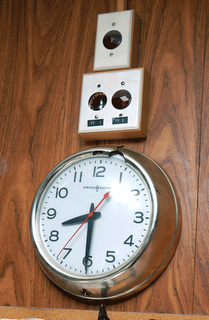
For as long as anybody working here can remember (and that takes us back into the First Era of Disco) our deadlines have been regulated by a plain electric GE clock that hung in the front of our newsroom. We didn't really think much about this trustworthy relic until the beginning or end of Daylight Savings Time each spring and fall, when whoever was the first to arrive on those Sundays had to change the time. This was no easy task, since the adjustment knob broke into a slippery, hard-to-turn metal rod years ago, and many of us have stories of sore fingers or searching the building for a pair of pliers to accomplish this chore.
Our electric task master finally gave up the ghost this week. Now, the death of a clock may not seem like a noteworthy event, but when you work at a newspaper, time is always paramount when a deadline is approaching. The press operators, mailroom staff and drivers can't wait for a story to be finished or a page to be laid out. They need
on-time and
now.So on those mornings (when we were an afternoon paper) and nights when some source on a breaking story didn't call back yet, a computer decided to lose a page or two, or the election results were not in yet (but expected
any minute), nervous editors glared at that clock, as if they could slow down the minute hand with their eyes
just long enough to make their deadline. Time is not so forgiving, of course, and each day's paper is frozen in time when that last page is sent. There may be another edition just 24 hours away, but in the print business, old news is no news.
So we watched that clock, each day, many times a day. Several decades, scores of writers, photographers and editors, thousands of deadlines.
With the rise of the internet, deadlines might not seem as relevant as they once were, but even now we know that readers tend to log on a certain times of the day, and if a breaking story is not posted by a certain time, fewer readers will see it. So we will continue check the time, doing everything we can to make all our deadlines.

 RSS
RSS

